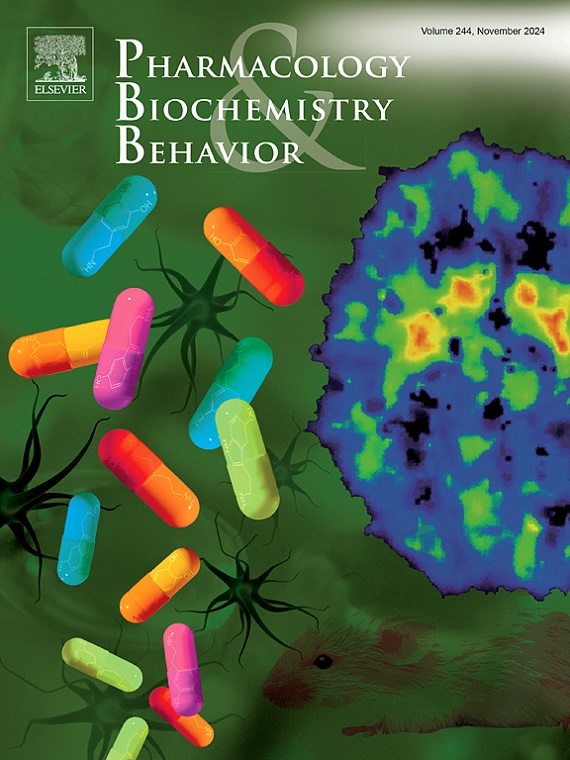Schizophrenia-like phenotypes and long-term synaptic plasticity impairment in GluN2A-transgenic mice
IF 3.3
3区 心理学
Q1 BEHAVIORAL SCIENCES
引用次数: 0
Abstract
While N-methyl-d-aspartate receptor (NMDAR) hypofunction has been suggested as a hallmark of schizophrenia, the role of subunit-specific dysregulation such as GluN2A overexpression remains poorly understood. The present study comprehensively investigated the impact of GluN2A overexpression on behavioral phenotypes, cognitive functions, and synaptic plasticity in transgenic mice with forebrain-specific overexpression of the GluN2A subunit (GluN2A-TG). Behavioral assessments revealed schizophrenia-like phenotypes, including prolonged stereotypic movement duration, impaired sensorimotor gating, reduced social interaction, and diminished nest-building activity in GluN2A-TG mice. Consistently, GluN2A-TG mice exhibited not only deficits in spatial working memory and olfactory working memory but also impaired associative learning. In addition, both long-term potentiation and long-term depression were significantly attenuated in the prefrontal cortex (PFC) of GluN2A-TG mice. Furthermore, electrophysiological analysis of NMDAR-mediated excitatory postsynaptic currents in PFC neurons revealed altered kinetics characterized by a faster decay time and significantly increased amplitude in GluN2A-TG mice. Collectively, these findings suggest that GluN2A overexpression may induce schizophrenia-like phenotypes via impairing NMDAR-dependent long-term synaptic plasticity in the PFC, likely due to altered NMDAR subunit composition leading to disrupted calcium signaling dynamics. These results provide critical insights into the pathological role of GluN2A in schizophrenia.
glun2a转基因小鼠的精神分裂症样表型和长期突触可塑性损伤
虽然n -甲基-d-天冬氨酸受体(NMDAR)功能低下已被认为是精神分裂症的一个标志,但亚单位特异性失调(如GluN2A过表达)的作用仍然知之甚少。本研究全面研究了GluN2A过表达对GluN2A亚基(GluN2A- tg)前脑特异性过表达转基因小鼠行为表型、认知功能和突触可塑性的影响。行为评估显示GluN2A-TG小鼠具有精神分裂症样表型,包括刻板印象运动持续时间延长、感觉运动门控受损、社交互动减少和筑巢活动减少。GluN2A-TG小鼠不仅表现出空间工作记忆和嗅觉工作记忆的缺陷,而且还表现出联想学习的障碍。此外,GluN2A-TG小鼠前额皮质(PFC)的长期增强和长期抑郁均显著减弱。此外,对nmdar介导的PFC神经元突触后兴奋性电流的电生理分析显示,GluN2A-TG小鼠的动力学发生了改变,其特征是衰减时间更快,振幅显著增加。总的来说,这些发现表明GluN2A过表达可能通过损害PFC中NMDAR依赖的长期突触可塑性来诱导精神分裂症样表型,可能是由于NMDAR亚基组成的改变导致钙信号动力学被破坏。这些结果为GluN2A在精神分裂症中的病理作用提供了重要的见解。
本文章由计算机程序翻译,如有差异,请以英文原文为准。
求助全文
约1分钟内获得全文
求助全文
来源期刊
CiteScore
6.40
自引率
2.80%
发文量
122
审稿时长
38 days
期刊介绍:
Pharmacology Biochemistry & Behavior publishes original reports in the areas of pharmacology and biochemistry in which the primary emphasis and theoretical context are behavioral. Contributions may involve clinical, preclinical, or basic research. Purely biochemical or toxicology studies will not be published. Papers describing the behavioral effects of novel drugs in models of psychiatric, neurological and cognitive disorders, and central pain must include a positive control unless the paper is on a disease where such a drug is not available yet. Papers focusing on physiological processes (e.g., peripheral pain mechanisms, body temperature regulation, seizure activity) are not accepted as we would like to retain the focus of Pharmacology Biochemistry & Behavior on behavior and its interaction with the biochemistry and neurochemistry of the central nervous system. Papers describing the effects of plant materials are generally not considered, unless the active ingredients are studied, the extraction method is well described, the doses tested are known, and clear and definite experimental evidence on the mechanism of action of the active ingredients is provided.

 求助内容:
求助内容: 应助结果提醒方式:
应助结果提醒方式:


